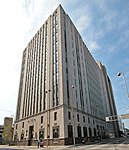Covenant First Presbyterian Church
AC with 0 elementsCincinnati Local Historic LandmarksNational Register of Historic Places in CincinnatiPresbyterian churches in CincinnatiPresbyterian churches in Ohio

The Covenant First Presbyterian Church is a congregation of the Presbyterian Church (USA) located at 717 Elm Street at Eighth Street and Garfield Place in Cincinnati, Ohio. Two churches, the First Presbyterian and Covenant Presbyterian merged in the 1933 to become the Covenant First Presbyterian Church. The first Presbyterian Church in Cincinnati was on the north side of Fourth Street near Main and was organized October 16, 1790.
Excerpt from the Wikipedia article Covenant First Presbyterian Church (License: CC BY-SA 3.0, Authors, Images).Covenant First Presbyterian Church
Elm Street, Cincinnati West End
Geographical coordinates (GPS) Address Phone number Website External links Nearby Places Show on map
Geographical coordinates (GPS)
| Latitude | Longitude |
|---|---|
| N 39.103888888889 ° | E -84.517222222222 ° |
Address
Covenant-First Presbyterian Church
Elm Street 717
45202 Cincinnati, West End
Ohio, United States
Open on Google Maps










